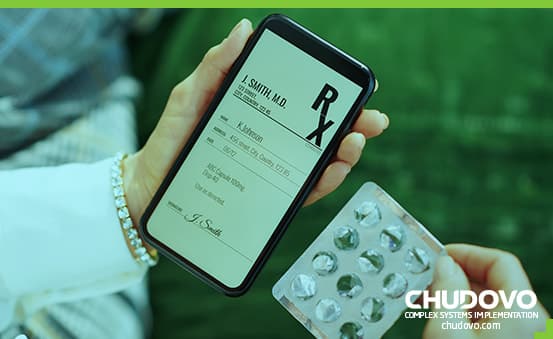Full Guide to Building Telemedicine Applications in 2023
In healthcare and indeed every facet of human life, technology continues to be the driving force behind transformative advancements. As we stand on the precipice of 2023, the telemedicine sector has emerged as a powerful agent of change, offering innovative solutions to the challenges faced by healthcare systems worldwide.
In this holistic guide, we will delve into the world of telemedicine app development, exploring its definition, significance, types, development steps, key features, mobile integration, cost considerations, and much more. Join me on this exciting journey as we navigate the intricate terrain of telemedicine. By the end, you’ll be well-equipped to get started with your own telemedicine app development project.
Table of content
- Definition of Telemedicine
- Types of Telemedicine Applications
- Steps to Develop a Telemedicine App
- 5 Key Features of Telemedicine Apps
- Role of Mobile in Telemedicine App Development
- Cost of Telemedicine App Development
- Choosing a Telemedicine App Development Company
- 5 Challenges in Telemedicine App Development
- Telemedicine Use Cases
- 5 Benefits and Pros of Telemedicine – list and explain
- Conclusion
- FAQ
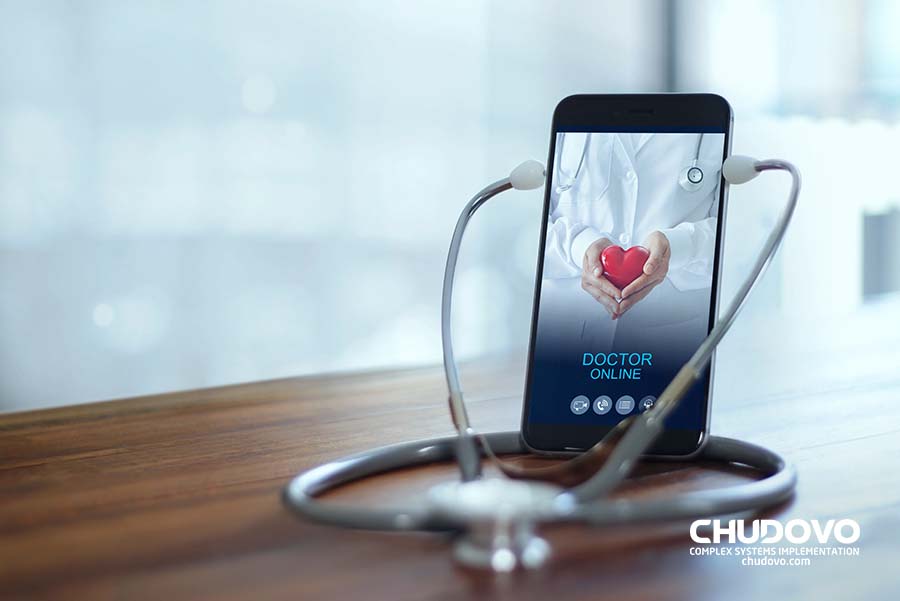
Definition of Telemedicine
Before diving into the nitty-gritty of telemedicine app development, let’s establish a solid foundation by defining telemedicine. Telemedicine, also referred to as telehealth, is the practice of providing healthcare services remotely using telecommunications technology. It encompasses various services, from video consultations with healthcare professionals to remote patient monitoring and the electronic transmission of medical records and images.
Importance and Impact of Telemedicine in Healthcare
The importance of telemedicine in healthcare cannot be overstated. In an era characterized by busy schedules and geographical constraints, telemedicine bridges the gap between patients and healthcare providers, offering convenience, accessibility, and timely care. Moreover, the COVID-19 pandemic accelerated the adoption of telemedicine, underscoring its significance in times of crisis.
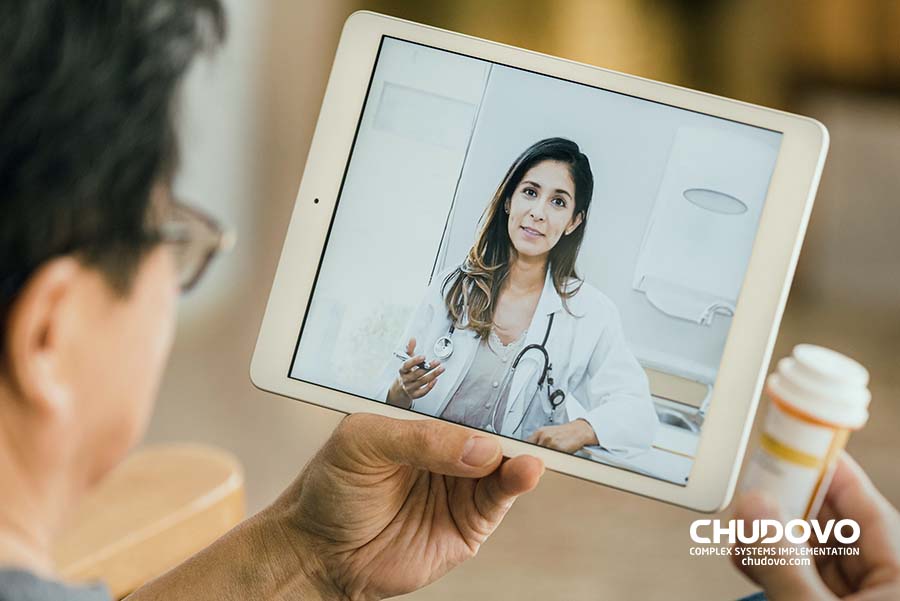
Types of Telemedicine Applications
To understand telemedicine app development extensively, it’s essential to recognize the various types of telemedicine applications available. Let’s explore three primary categories:
Real-time Telemedicine
Real-time telemedicine involves synchronous communication between patients and healthcare professionals. This mode of telemedicine facilitates live video consultations, allowing patients to interact with their doctors in real time. It’s a vital component of telemedicine, offering immediate access to medical advice and care.
Store-and-Forward Telemedicine
Store-and-forward telemedicine, on the other hand, is an asynchronous method. It involves the secure transmission of patient data, such as medical records, images, and test results, to healthcare providers for later review and diagnosis. This approach is particularly useful for cases that do not require immediate attention.
Remote Patient Monitoring
Remote patient monitoring (RPM) leverages technology to collect patient data from a distance, such as vital signs and health metrics. This allows healthcare providers to track patients’ health conditions in real time, allowing for proactive interventions when necessary. RPM is particularly valuable for chronic disease management and post-operative care.
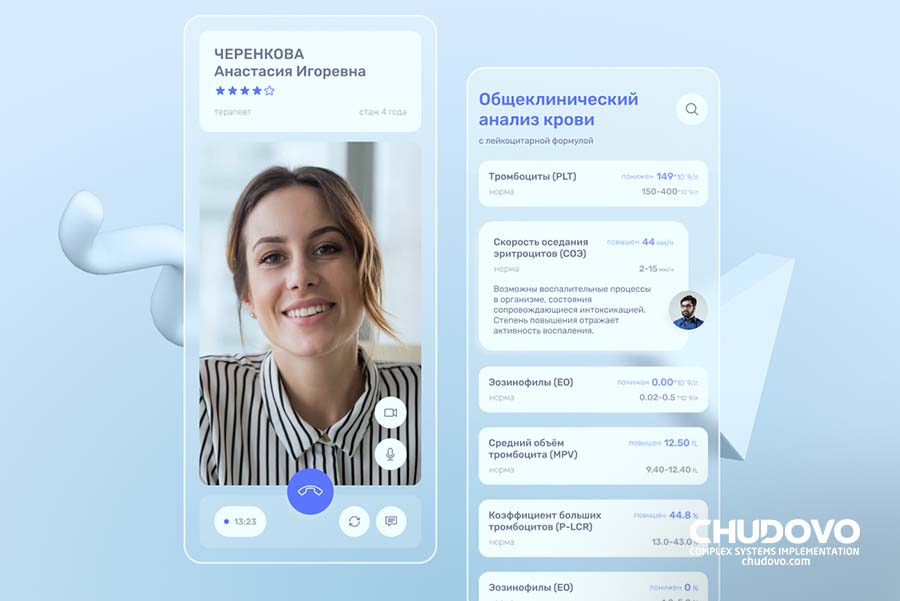
Steps to Develop a Telemedicine App
Now that we clearly understand the different types of telemedicine applications let’s explore the idea of how to develop a telemedicine app. Here are the essential steps to follow:
Initial Research and Planning
Every successful telemedicine app development project begins with thorough research and meticulous planning. Here, you define your project goals, target audience, and the unique value proposition your app will offer. That’s not all; you will also Identify potential competitors and conduct market research to understand current trends and user preferences.
Designing a User-Friendly Interface
The user interface (UI) and user experience (UX) of your telemedicine app are critical factors in its success. Design an intuitive and user-friendly interface that simplifies the patient’s journey, from registration and appointment scheduling to conducting consultations. Prioritize features that enhance usability, such as secure messaging and easy navigation.
Backend and Frontend Development
The backbone of your telemedicine app lies in its backend and frontend development. Ensure robust security measures to protect patient data and comply with healthcare regulations. On the front end, focus on creating a visually appealing and responsive design that works seamlessly across various devices and platforms.
Quality Assurance and Testing
Thorough testing is paramount in the development of telemedicine apps. Conduct rigorous testing to identify and rectify any bugs or vulnerabilities. Test the app’s functionality, security, and performance to guarantee a smooth and secure user experience.
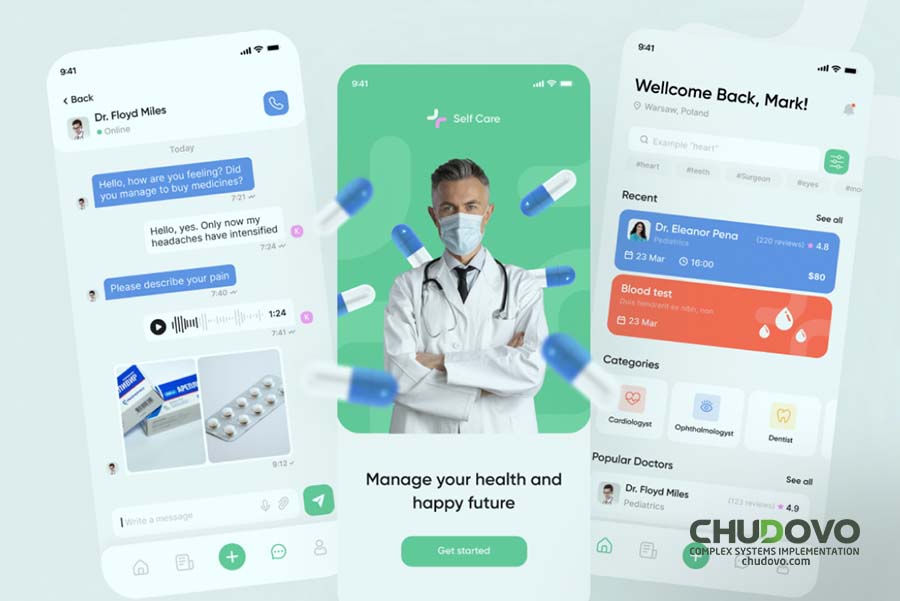
5 Key Features of Telemedicine Apps
To create a successful telemedicine app, you must incorporate essential features that cater to the needs of both patients and healthcare providers. Here are five key features to consider:
1. Video Consultation
One of the cornerstone features of telemedicine apps is video consultation. It effectively transcends the limitations of geography, enabling patients and healthcare professionals to engage in face-to-face interactions, albeit through screens. Here’s why this feature is essential:
- Personalized Care: Video consultations allow patients to establish a personal connection with their healthcare providers. This sense of familiarity and trust is vital in the doctor-patient relationship.
- Visual Diagnostics: Healthcare providers can visually assess patients, observing physical symptoms, expressions, and body language, which aids in diagnosis.
- Accessible Specialists: Patients can consult with specialists regardless of location, ensuring they receive the best care, even in remote areas.
2. Appointment Scheduling
Efficient appointment scheduling is crucial for both patients and doctors. Implement a user-friendly scheduling system that allows patients to book appointments based on their preferences and availability. Integration with calendar apps can simplify this process further.
3. Prescription and Pharmacy Integration
Seamless prescription management and pharmacy integration enhance the overall user experience. Enable doctors to electronically prescribe medications and integrate with local pharmacies for convenient prescription fulfillment and delivery services.
4. Secure Messaging
Secure messaging within telemedicine apps fosters ongoing communication between patients and healthcare providers through the following ways:
- Non-Emergency Queries: Patients can send non-urgent medical inquiries to their healthcare providers, ensuring quick responses without the need for appointments.
- Medication Clarifications: Patients can seek clarifications regarding their medications or treatment plans, enhancing medication adherence.
- Follow-Up Care: Healthcare providers can easily follow up with patients to monitor progress, answer questions, and adjust treatment plans.
5. Health Record Access
A telemedicine app’s capability to provide access to health records is instrumental in patient empowerment and comprehensive care. Here are some of the reasons why this is important:
- Data Accessibility: Patients can access their medical history, test results, and treatment plans, empowering them to actively engage in their healthcare.
- Information Sharing: Patients can securely share their health records with multiple healthcare providers, facilitating coordinated care.
- Emergency Situations: In critical situations, access to medical history can be lifesaving, as emergency healthcare providers can quickly retrieve essential information.
- These aforementioned features collectively offer convenience, accessibility, and a comprehensive healthcare experience that empowers both patients and healthcare providers.
Role of Mobile in Telemedicine App Development
In an age where smartphones have become extensions of ourselves, it’s only natural that they play an instrumental role in the evolution of telemedicine. The synergy between mobile devices and telemedicine apps has led to a healthcare revolution, transforming how we access medical services. This section will explore the multifaceted role of mobile devices in telemedicine app development, highlighting the development process and uncovering the benefits they bring to patients and healthcare providers.
Mobile App Development Process
Here’s a comprehensive guide to developing a telemedicine mobile app:
- Ideation and Conceptualization: The journey begins with ideation, where the app’s purpose, target audience, and distinctive features are defined. Creating a concept that aligns with the app’s mission is crucial to providing accessible healthcare.
- Designing the User Experience (UX): Creating wireframes and prototypes is vital to visualize the app’s layout and user flow. In telemedicine, the user interface must be intuitive, prioritizing ease of use for patients and healthcare providers.
- Development Phase: The backbone of the app is constructed through coding. This stage involves translating the conceptual design into functional code while ensuring that telemedicine-specific features, such as video conferencing and appointment scheduling, are seamlessly integrated.
- Testing and Quality Assurance: Rigorous testing is conducted to identify and rectify any issues, ensuring the app functions reliably across various devices and platforms. It’s essential to verify the security and stability of the app, given the sensitivity of healthcare data.
Benefits of Mobile Telemedicine Apps
The role of mobile devices in telemedicine extends far beyond convenience—it’s about revolutionizing healthcare accessibility. Here are four key benefits that mobile telemedicine apps offer:
- Accessibility: Mobile apps bring healthcare services directly to the patient’s pocket, ensuring accessibility from virtually anywhere, at any time. This is especially crucial in emergencies and for individuals with mobility challenges.
- Convenience: Patients can schedule appointments, consult with healthcare providers, and manage their health on the go. This convenience is a game-changer, reducing the barriers to healthcare access.
- Real-time Communication: Mobile apps facilitate real-time communication between patients and healthcare providers. Patients can receive timely care and support, while providers can offer immediate guidance.
- Health Monitoring: Integration with wearable devices enables continuous health monitoring. Patients can track vital signs and health metrics, providing healthcare providers with valuable data for remote assessment.
As we look to the future, integrating mobile technology with telemedicine will continue to evolve. With ongoing advancements in wearable devices, improved user interfaces, and enhanced data security, the impact of mobile devices on telemedicine is poised to become even more profound, promising better healthcare outcomes and a healthier society.
Cost of Telemedicine App Development
Understanding the cost considerations of telemedicine app development is crucial for budgeting and financial planning. Let’s explore the factors affecting development costs and conduct a cost breakdown analysis:
Factors Affecting Development Cost
The following are factors affecting the cost of the development of a telemedicine app:
- Features and Complexity: The complexity and number of features you incorporate into your app will significantly impact development costs. Advanced features like AI-driven diagnostics or secure data storage will require more investment.
- Development Team: The size and expertise of your development team influence costs. Hiring experienced developers and designers may come at a higher price but can lead to a more polished product.
- Compliance and Security: Ensuring compliance with healthcare regulations and implementing robust security measures are essential but may add to development costs.
- Integration: Integrating third-party services, such as video conferencing tools or pharmacy databases, can incur additional expenses.
- Maintenance and Updates: Post-launch maintenance and updates are ongoing costs that should be factored into your budget.
Approximate Cost Breakdown Analysis for Telemedicine App Development
Here’s a tabulated breakdown of the approximate costs associated with telemedicine app development:
| Cost Component | Approximate Percentage of Total Cost |
| Development Team | 40% |
| Features and Complexity | 30% |
| Compliance and Security | 15% |
| Integration | 10% |
| Maintenance and Updates | 5% |
This breakdown provides a clear overview of the distribution of the total development cost among various key components. Please note that these percentages are approximate and can vary depending on the specific project requirements and goals.
Choosing a Telemedicine App Development Company
Selecting the right telemedicine app development company is a critical decision that can profoundly impact the success of your project. Here are seven things to look for when choosing a telemedicine development company:
- Expertise in Healthcare: Ensure the selected company deeply understands the healthcare industry. Their experience with healthcare-related projects ensures they comprehend the nuances and regulatory requirements of this specialized field.
- Compliance Knowledge: Healthcare is governed by strict regulations, such as HIPAA in the United States and GDPR in Europe. Ensure the development company is well-versed in compliance and can create a secure, regulatory-compliant solution.
- Portfolio Assessment: Review the company’s portfolio to evaluate the quality of their previous work. Seek evidence of their experience in telemedicine app development or related healthcare projects.
- Security Protocols: In the realm of healthcare, data security is paramount. Inquire about the development company’s security protocols and their commitment to safeguarding sensitive patient information.
- Customization Options: The ability to tailor the app to your specific requirements and branding is crucial. Ensure the development company can create a solution that aligns with your vision.
- Support and Maintenance: Post-launch support and maintenance are vital for the long-term success of your telemedicine app. Clarify the level of support the development company offers and their responsiveness to maintenance needs.
- Client References: Request client references and reach out to past clients to gain insights into their experience with the development company. Direct feedback from previous clients can provide valuable information.
Selecting a telemedicine app development company like Chudovo is a critical step in bringing your healthcare vision to life. By meticulously evaluating potential partners based on expertise, compliance knowledge, portfolio quality, security measures, customization options, support capabilities, and client references, you can ensure that your telemedicine project is in capable hands.
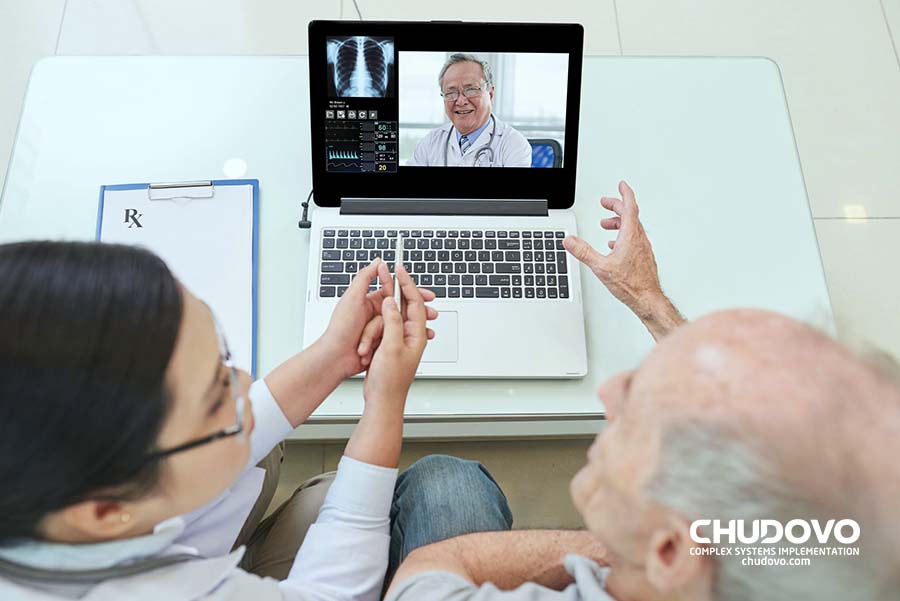
5 Challenges in Telemedicine App Development
While the prospects of telemedicine app development are promising, it’s essential to be aware of the challenges that may arise during the process. Here are five common challenges and strategies to address them:
- Regulatory Compliance Complexity: The healthcare industry is heavily regulated, with data privacy and security being paramount concerns. Telemedicine apps must comply with regulations such as HIPAA, GDPR, and local healthcare laws. Ensuring strict adherence to these regulations while maintaining user-friendliness and accessibility can be daunting.
- Data Security and Privacy: Telemedicine apps handle sensitive patient information, making data security a top priority. Developing robust security measures to protect patient data against potential breaches and ensuring encryption of communications are ongoing challenges.
- User Adoption Hurdles: Convincing healthcare providers and patients to embrace telemedicine can be challenging. Users may be resistant to change or skeptical about the effectiveness of remote healthcare services. Overcoming these adoption hurdles requires comprehensive education and user-friendly app design.
- Complex Integration Requirements: Telemedicine apps often need to integrate with various healthcare systems, electronic health records (EHRs), and third-party services. Achieving seamless interoperability can be complex and time-consuming, requiring developers with expertise in healthcare data exchange standards.
- Quality Assurance and Testing: Ensuring the reliability and performance of telemedicine apps is critical. Rigorous testing is essential to identify and rectify issues, including bugs, connectivity problems, and potential vulnerabilities. Quality assurance in healthcare apps demands meticulous attention to detail.
The continued evolution of telemedicine technology promises to overcome these challenges, ultimately improving patient outcomes and revolutionizing the healthcare industry. By meeting these challenges head-on, we move one step closer to a future where telemedicine is integral to global healthcare accessibility.
Telemedicine Use Cases
As telemedicine emerges as a potent force in modern healthcare, its real-world applications span various scenarios and settings. In this section, we will delve into the versatile use cases of telemedicine:
Telemedicine in Action: Real-world Use Cases
- Remote Consultations for Primary Care: Telemedicine has empowered patients to seek care remotely. Patients can connect with healthcare providers for common ailments, preventive care, and general health inquiries without the need for physical visits. This approach enhances accessibility and reduces the burden on traditional healthcare facilities.
- Specialist Consultations: Telemedicine extends specialized care to patients in remote or underserved areas. Accessing specialists such as dermatologists, cardiologists, or neurologists is no longer restricted by geographical limitations. Patients can receive expert consultations via video conferencing, ensuring timely diagnosis and treatment.
- Mental Health Support: Telemedicine has played a pivotal role in improving mental health access. Patients can connect with therapists, counselors, and psychiatrists for counseling sessions, therapy, and medication management. This is particularly beneficial for those facing stigmatization or physical barriers to mental healthcare.
- Chronic Disease Management: Telemedicine offers a lifeline for individuals with chronic conditions. Patients can use remote monitoring devices and telehealth apps to track vital signs, receive medication reminders, and share health data with healthcare providers. This continuous monitoring enables timely interventions and reduces hospital readmissions.
2 Real-world examples of companies that have successfully implemented telemedicine
Now let’s explore two real-world examples of companies that have successfully implemented telemedicine solutions:
- Teladoc Health: Teladoc Health is a leading telemedicine company offering virtual healthcare services, including video consultations, for various medical conditions. They have revolutionized how patients access healthcare, making it more convenient and accessible.
- Amwell: Amwell provides a telehealth platform that connects patients with healthcare providers through video visits. They serve various healthcare sectors, including primary care, urgent care, and mental health.

Certified engineers
Convenient rates
Fast start
Profitable conditions
Agreement with
EU company
English and German
speaking engineers
7 Benefits and Pros of Telemedicine
Telemedicine offers a plethora of benefits that extend beyond convenience. Here are seven exciting advantages to look out for:
- Accessibility: Telemedicine breaks down geographical barriers, ensuring access to healthcare services for individuals in remote or underserved areas.
- Convenience: Patients can consult with healthcare professionals from the comfort of their homes, eliminating the need for travel and long waiting times.
- Timely Care: Real-time communication enables swift responses to medical concerns, reducing delays in diagnosis and treatment.
- Continuity of Care: Patients can maintain ongoing relationships with healthcare providers, promoting better continuity of care.
- Cost Savings: Telemedicine can reduce healthcare costs by minimizing travel expenses and hospital readmissions.
Conclusion
Telemedicine has revolutionized healthcare by breaking down geographical barriers, offering remote access to healthcare services, and reshaping patient-provider dynamics. Key takeaways include heightened accessibility, patient-centric care, data security priorities, and interdisciplinary collaboration. As we look forward, telemedicine promises a holistic care continuum, empowered patients, data-driven healthcare, global health equity, and ongoing innovation through technology integration. This transformative journey invites us to reimagine healthcare and embrace its boundless potential to enhance the well-being of humans on a global scale.
FAQ
How secure is telemedicine for sensitive patient information?
Telemedicine platforms prioritize data security. They use encryption and comply with healthcare regulations like HIPAA to safeguard patient information. However, choosing a reputable provider with a strong focus on security is essential.
Can telemedicine replace in-person medical visits entirely?
While telemedicine offers many benefits, it cannot entirely replace in-person visits, especially for physical examinations and procedures that require hands-on care. It complements traditional healthcare by offering convenience and accessibility.
Does insurance cover telemedicine apps?
Many insurance providers now cover telemedicine services, but coverage varies. It’s advisable to check with your insurance company to understand your policy’s telemedicine coverage.
What devices are compatible with telemedicine apps?
Telemedicine apps are typically compatible with smartphones, tablets, laptops, and desktop computers. Ensure your chosen app is available on the device you plan to use for consultations.
Now, it’s time to take action. If you’re ready to embark on your telemedicine app development journey, I encourage you to partner with Chudovo, a reputable and experienced telemedicine app development company.


